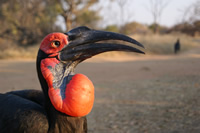Dow Southern Africa and the FitzPatrick Institute join forces for Southern Ground-Hornbill conservation in their joint 50th Anniversaries

In the 50th Anniversary year of the Percy FitzPatrick Institute at the University of Cape Town, some exciting terrestrial bird projects are underway. One of these is investigating the conservation problems surrounding Southern Ground-Hornbills Bucorvus leadbeateri, an iconic species of the African savannas. Further great news is that Dow Southern Africa (Pty) Ltd, also in their 50th Anniversary year, have committed R500 000 to the Dow Ground-Hornbill Project for the year September 2010 to August 2011. This brings the support from Dow for the project to R1.5 million over the past seven years!
Dow’s journey into the South African market commenced with the opening of a sales office in Johannesburg in 1959 and today the Company is a significant local industry player with an annual turnover of R1.4 billion. From a single entry point, Dow presently employs more than 200 people based in eight locations spread over five of South Africa’s provinces.
During the course of the 20th Century, the range and population size of the Southern Ground-Hornbill in South Africa decreased by some two thirds, with the birds disappearing from much of their historical range. In many cases, however, the causes of those local extinctions are known, and in some instances these are no longer operative. Because of the ground-hornbills’ complex social structure, living in groups within which only a single pair breeds, self-reintroduction would, at best, be very slow. This means that reintroduction programmes need to be considered in an attempt to improve the species’ precarious conservation status.
The Dow Ground-Hornbill Project aims to firstly gain a scientific understanding of the environmental conditions that promote successful breeding, and secondly to use this knowledge to identify areas previously occupied by ground-hornbills that are now suitable for their reintroduction.
The study is supported by 10 years of monitoring data for more than 20 ground-hornbill groups at the Institute’s 180 000 ha lowveld study site at the Associated Private Nature Reserves adjacent to the Kruger National Park. The knowledge gained includes group composition, nest parameters and reproductive performance. Some ground-hornbill groups have been carrying satellite transmitters for almost a year, transmitting positional data hourly. This information can be overlaid on a detailed vegetation map of the area to assess daily and seasonal patterns of habitat use, which will be used to guide reintroduction programmes in terms of identifying optimal habitat mosaics. The study will thus help to generate an increase in the Southern Ground-Hornbill population and an expansion back into as much of its historical range as possible.
IMAGE: Southern Ground Hornbill photo taken by Kate Meares.
Find out more about the following research programmes: Rarity & Conservation of African Birdsand Cooperative Breeding & Sociality in Birds.
